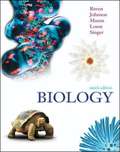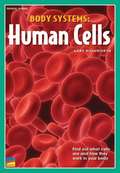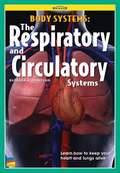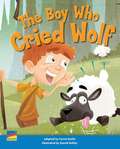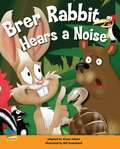- Table View
- List View
More NIMAC books are available at www.nimac.us. If you find your title in the NIMAC and not in Bookshare then please contact us to request it.
Ben Franklin, Apprentice Printer; The Education of Abigail Adams
by Angelo Parra Helen PavlacWhat will teenage Ben Franklin do to get his stories printed in his brother's newspaper? How will a chance meeting with young John Adams change Abigail's attitude toward school and learning? Read this book to find out.
The Best Place to Live: Set of 6 (Readers' and Writers' Genre Workshop Ser.)
by Sarah AlbeeNIMAC-sourced textbook
Big Day in the Neighborhood (Reach Into Phonics Ser.)
by Jamie Rowley Nonie K. Lesaux Sylvia Linan ThompsonNIMAC-sourced textbook
Biology
by Kenneth A. Mason Jonathan B. Losos Susan R. SingerCommitted to Advanced Placement Biology! Committed to Students New pedagogical features to guide student learning Each chapter begins with an outline of the chapter. Learning outcomes are included for every major topic to help students see the forest for the trees and focus on the main concepts and relationships of the details being presented to them. Scientific Thinking illustrations are highlighted and provide students with questions, as well as a hypothesis, prediction, observation, experiment, etc. , as appropriate to guide their thought process and teach them to think like a scientist. Inquiry questions are found throughout the text to push the students further in their ability to think scientifically. Learning outcomes are revisited with a short review prior to moving on to the next major topic. A logically organized summary is available at the end of each chapter for students to use as a quick study tool. End of chapter review questions include Understanding, Applying and Synthesizing levels. Committed to Biology Teachers The dynamic author team comprised of Jonathan Losos, Evolutionary Biologist at Harvard University, Ken Mason, Molecular Biologist at University of Iowa, and Susan Singer, Plant Geneticist, Carleton College, have joined forces to move this high-quality textbook forward in a significant way for a new generation of students. All three authors have extensive experience teaching undergraduate biology and have used this knowledge as a guide in producing a text that is up-to-date, beautifully illustrated, and pedagogically sound for the student. They have provided clear, explicit learning objectives, and more closely integrate the text with its media support materials to provide instructors with an excellent complement to their teaching. Committed to Today’s Learning EnvironmentConnect™ High School Study Center Enhanced Image and Lecture PPt New Animations Active Learning Exercises Learn Engaging, Interactive Questions and Activities Student Self Study Succeed Enhanced Testbank Powerful Diagnostics and Reports for Students and Instructors Connect Plus eBook Request an Examination Copy Visit the Online Learning Center
A Biome of the World: The Taiga
by Carol TalleyThe final installment of the Reading Street curriculum series, Reading Street: Grade 6, comes complete with everything you'll need to create English and Language Arts lessons for your child. This system includes reading selections designed to help your child hone his or her skills, a Teacher Resource DVD to make your task of developing lessons easier, and a packet of curriculum materials. Reading Street: Grade 6 is a comprehensive system designed to enhance your child's skills in reading, writing and language. Each assignment in Reading Street helps your child progress toward that goal. While such a dynamic curriculum might sound challenging for you as a parent and educator to use, you can rest assured that the materials will guide you through 12 weeks of English and Language Arts lesson planning with ease. If you prefer a structured homeschooling program format, Reading Street (in all of its Grade level structures) is the right fit for you and your child. Grade 6 comes with two volumes of six units. By the time you complete Grade 6, your child will be able to: Read through a variety of complex literature, including biographies and fictional stories. Discover additional reading material based on personal taste. Relate individual chapters or concepts to the book as a whole. Write complete stories using proper grammar, punctuation and word choice. Compose a written argument using appropriate sources. Examine and edit his or her own writing, as well as the writing of others. Present an oral presentation based on the lessons. Unlike other curricula, Reading Street imparts a love of reading upon your child. From Grade 1 through Grade 6, your child will learn not only the skills he or she needs to advance his or her education, but become a lifelong student and reader. For more information about the specific materials included in the Reading Street: Grade 6 curriculum for homeschooling, visit the Features and Benefits page.
The Bird Rescue: Arctic Adventures Chapter Book Set (Arctic Adventures Chapter Series)
by Michèle DufresneNIMAC-sourced textbook
Blizzard!
by Ellen Dreyer Sadami HiguchiThe fun and excitement of English and Language Arts learning continues in Grade 2 of Reading Street. This comprehensive and dynamic curriculum for homeschooling is geared toward young children who have some foundational English and Language Arts knowledge and are ready to strengthen their skills. Comprised of engaging activities, challenging content and weekly quizzes, Reading Street: Grade 2 is the next step in your child's path toward becoming a lifelong learner and reader. As with all Reading Street products, the Grade 2 system is formatted to help students meet certain age-appropriate goals. After completing this English and Language Arts homeschool program, your child should be able to: Read and comprehend two-syllable words. Identify common prefixes (such as pre-, un-, or re-) and suffixes (such as -able, -ad and -er). Correct mistakes made when reading out loud. Read books with two or more chapters. Understand the structure of stores (i. e. beginning, middle and end). Start selecting reading materials based on his/her own interests. Identify the "who," "what," "when," "where," "why" and "how" of the text. While the goals of second Grade English and Language Arts are numerous, Reading Street will help you craft engrossing lessons. Your child will garner important English and Language Arts skills while completing a workbook, reading stories and poems, and taking assessments. Planning these lessons will be easier than ever, as all Reading Street systems are broken down into weekly Big Ideas. All the work your child does on a given week is formulated around that single concept for an organized and challenging curriculum. With six easy-to-follow units, Reading Street: Grade 2 is the perfect tool for homeschooling parents. Your child will enjoy the reading selections and activities, and you'll love to see your student growing into a knowledgeable individual. We're confident that this product is the right one for you. For more information on the specific materials found in Grade 2 of Reading Street, check out the Features and Benefits page.
Bodies Fins and Stripes (Reach Into Phonics Ser.)
by Dee Wallis Kelsey Bruce Deborah J. ShortNIMAC-sourced textbook
Body Systems: The Respiratory and Circulatory Systems
by Barbara A. Donovan Margaret McnamaraLearn about how the respiratory and circulatory systems work to keep the human body alive.
The Boy Who Cried Wolf
by Carrie Smith Gerald Kelley Sera Y. ReycraftA lonely shepherd boy teaches a lesson about telling the truth. Read to find out what happens when a boy who is known to lie finally tells the truth.
The Brain
by Jeanette LeardiThe human brain weighs less than four pounds, is made up of more than 100 billion cells, and is the control center of every human being. It keeps humans alive, allows them to experience emotions, and enables them to think and learn. How does this small organ manage to do so much? What should humans do to protect it? Read these informational texts to find out.
Brer Rabbit Hears a Noise
by Alison Adams Bill Greenhead Sera Y. ReycraftClassic Tales: Brer Rabbit Hears a Noise

